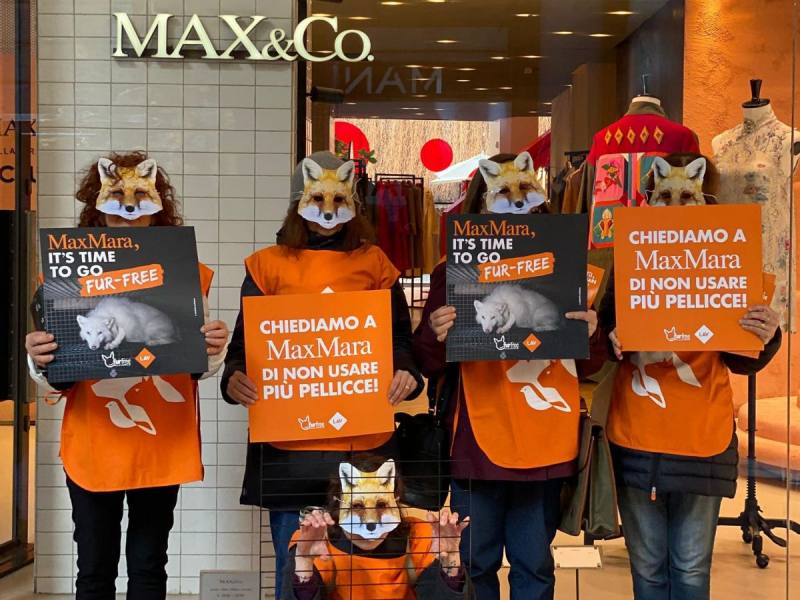

We were on a spectacular hot air balloon flying over the fashion group's headquarters in Reggio Emilia.
"Max Mara GO FUR-FREE!” is the message we launched with Humane Society International, along with all members of the Fur Free Alliance, to the Italian fashion house Max Mara, with a spectacular hot air balloon flying over the fashion group's headquarters in Reggio Emilia, on the occasion of Milan Fashion Week, which started Thursday, Feb. 22
The balloon stunt was part of the activities of the global campaign #FurFreeMaxMara, launched by the 50+ members of the Fur Free Alliance, during the current fashion month (Feb. 9 – March 3), to urge all brands of the Max Mara Fashion Group such as Marina Rinaldi, Sportmax, Max&co., Pennyblack and others besides Max Mara to ditch animal fur.
The Max Mara Group, which has over 2,500 stores in 105 countries, is one of the last major brands to use fur. The current range includes items made from fox, raccoon dog and mink.
Among Max Mara's fur products are fox fur cuffs, a mink trimmed hood, a fox fur trimmed hood, mink mittens, a fox fur trimmed parka and raccoon dog fur accessories for bags.

Furthermore, product labels reveal that the company uses mink fur from China and fox and raccoon dog fur from Finland, a country where over 70 outbreaks of highly pathogenic avian Influenza H5N1 have already been documented specifically in fur farms.
With the reach of the Fur Free Alliance, represented by its members in 35 countries, the #FurFreeMaxMara campaign is the largest corporate anti-fur campaign of all time, with tens of thousands of emails and calls to the company's phones and actions both on social media and at the company's retail outlets. To get the message across, LAV and HSI have opted to convey it blatantly and unequivocally to the brand's headquarters: with a 25-meter-high hot air balloon.
If until yesterday the Maramotti family, along with the management of the Max Mara Fashion Group, did not listen to our request for dialogue and exchange regarding the unsustainability of fur production, today they certainly could not have missed our message ‘Max Mara Go Fur-Free!' coming from the sky with a hot-air-balloon. If the company continues to ignore our invitation, we will continue to involve thousands of people around the world until we achieve a definitive fur-free policy.
It is inconceivable that the Max Mara Fashion Group has ignored appeals to join the fur-free movement for so long, failing to see the need to align with the demands and sensitivities of modern consumers. Proposing a more ethical fashion is not only the right thing to do, but also an imperative in a context characterized by numerous textile innovations and increasingly avant-garde competitors. We hope that our message from the sky has been received!
Most of the world's major fashion houses have already eliminated fur from their collections. These include Dolce & Gabbana, Saint Laurent, Valentino, Gucci, Versace, Alexander McQueen, Balenciaga, and Jimmy Choo.
Other brands — Hugo Boss, Armani, Tommy Hilfiger, Stella McCartney and Vivienne Westwood — have long-standing policies against using fur. By comparison, Max Mara's use of fur makes the group increasingly out of mode.
Mink, fox, and raccoon dogs — all species used by the Max Mara Fashion Group — spend their entire lives in wire mesh cages, in conditions of poor welfare, deprived of the ability to express their natural behaviours, only to be killed by gas or anal electrocution.
Fur farming and processing is also environmentally devastating and a risk to public health.
Farms and tanneries can be extremely harmful to the soil and watercourses, as waste and toxic chemicals can leach into the surrounding environment.
Additionally, when compared to other materials, per kilogram fur has the highest greenhouse gas emissions, with, for example, the carbon footprint of 1 kg of mink fur 31 times higher than that of cotton and 25 times higher than polyester.
Fur facts:
Fur farming is already banned in 20 European countries, including 15 EU Member States: Austria, Belgium, Bosnia and Herzegovina, Czechia, Croatia, Estonia, France, Ireland, Italy, Latvia, Lithuania, Luxembourg, Macedonia, Malta, Norway, the Netherlands, the United Kingdom, Serbia, Slovakia, and Slovenia.